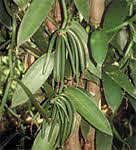See also: Article on Vanilla
VANILLA

Vanilla was used by the Aztecs to flavor chocolate, and they introduced the Spanish explorers to both.
The first use of vanilla dates back to Mexico, where the Aztecs used it to create a drink called Xoco-lall, made from cocoa and vanilla beans. Cortez is credited with bringing vanilla back to Spain and soon, its use spread to other parts of Europe. Today, vanilla beans from Madagascar are the gold standard to which all others are compared. Madagascar produces the majority of the world’s vanilla; however, vanilla is also grown in such tropical climates as Indonesia, Mexico, Uganda, Tonga, and Comoros.
The vanilla plant, Vanilla planifolia, is a slender, green-stemmed creeping or climbing perennial of the orchid family. Cultivating vanilla beans is a lengthy and labor-intensive process, as each flower must be hand pollinated to ensure it produces a bean. To complicate matters, a flower only lives for one day. Its beans grow to between 6 and 10 inches long and resemble a green string bean. Knowing the vanilla products to which we’re accustomed, it’s hard to believe that freshly harvested vanilla beans have no flavor or aroma. To develop their signature flavor, the beans must endure an elaborate, three- to four-month curing and sun drying process. Once this is complete, the beans are graded and bundled to ship to the United States.
When the beans arrive in the United States, they are either packaged as vanilla beans, or used to create the amber liquid known as the magic spoonful – pure vanilla extract. They are chopped and percolated in large stainless steel containers, much like coffee percolators. The vanilla extract is aged to perfection before it is bottled and sent to the grocery store.
McCormick - Spices & Seasonings - www.mccormick.com
The next time you are in the grocery store and wonder why pure vanilla extract is so expensive, consider the following:
- The vanilla bean is the fruit of a tropical American species of orchid. It is the one of the few orchids which produce anything edible and there are more than 20,000 orchid varieties.
- The plant produces one flower which lasts for only one day. If it is not pollinated, it will be another year before it flowers again.
- After the flower is pollinated (usually by hand using a wooden 'needle'), it takes about 6 weeks for the bean pod to develop and reach full size (6 to 10 inches), and another 9 months to mature.
- The pods are then hand picked, and dipped immediately in boiling water to stop growth. Initially, the vanilla bean has no flavor or aroma. The beans must be cured by heating in the sun during the day and wrapping them to sweat at night, for up to 20 days.
- They are then air dried in trays for 4 to 6 months, and during this process the beans ferment and develop their unique aroma and flavor.
- The cured pods contain about 2% vanillin (the main flavor component), oleoresin, sugar, aldehydes, alcohols, esters, etc., which all contribute to its unique aroma and flavor.
- The cured beans are then crushed and the the flavors extracted with with water and alcohol.
You are here > Home > FOOD TRIVIA & FACTS >
Please feel free to link to any pages of FoodReference.com from your website.
For permission to use any of this content please E-mail: james@foodreference.com
All contents are copyright © 1990 - 2025 James T. Ehler and www.FoodReference.com unless otherwise noted.
All rights reserved. You may copy and use portions of this website for non-commercial, personal use only.
Any other use of these materials without prior written authorization is not very nice and violates the copyright.
Please take the time to request permission.
FOOD TRIVIA and FOOD FACTS
Also see: Food Articles and Cooking Tips
Popular Pages
Home | Articles | FOOD TRIVIA | Today in Food History | Food Timeline | Recipes | Cooking_Tips | Food Quotes | Who’s Who | Culinary Schools & Tours | Food_Trivia_Quizzes | Food Poems | Free_Magazines | Food Festivals & Events
FoodReference.com (since 1999)
FOOD TRIVIA and FOOD FACTS SECTION

